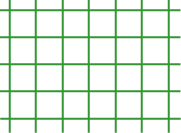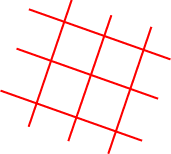|
6. EQUAL SQUARES A simple shape like the square tessellates the plane in a regular way, and we can obtain nice dissections by placing one such tessellation on top of another. In a tessellation of squares, the squares may be all the same size, or may occur in different sizes. |
|
|
|
Problem S1. Dissect a square into 2 equal squares. This problem is trivial (try it!), but we can use it to illustrate a new technique. At left is a portion of a tessellation of green 1-squares. Superimposed is a portion of a tessellation of red In terms of area, this is a problem with 1-squares and Problem S2. (a) Dissect a square into 10 equal squares. (Abu'l-Wafa) (b) Dissect 5 equal squares into 2 equal squares. To carry out Part (a) we superimpose on the tessellation of green 1-squares, a red square grid of side length Part (b) is more tricky. We use a red grid of half the size, but with the same orientation. If the green squares have area 1, what is the area of a red square? Place the red grid so that the central point lies at the centre of a green square. Now compare the 5-square green cross with two adjacent red squares. You should get a 12 piece dissection of one to the other. In this solution figure, notice that the 6 red pieces outside the green cross fit exactly onto the portion of the green cross outside the two shaded red squares. |




